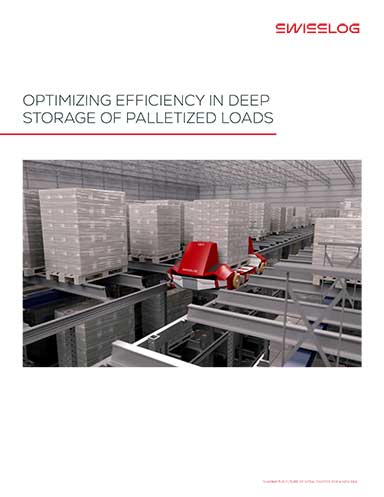Addressing the Challenges of Scalability in the Ecommerce Omnichannel Warehouse

While ecommerce continues to be the fastest growing segment of the global economy, individual warehouses face more volatility and unpredictability, and intelligent, modular robot-based automation delivers the flexibility to manage seasonal or sustained growth while minimizing the risk of over-reliance on human labor.
Challenge of Scalability in the Ecommerce Warehouse
Perhaps no warehouse has to deal with a greater level of volatility and unpredictability as an ecommerce or omnichannel fulfillment center.
When you look at a line chart of ecommerce growth over the last five years, it has been remarkably consistent.
According to Statista, in the U.S. alone, retail ecommerce growth rose from $298 billion in 2014 to $342 billion in 2015 to $390 billion in 2016 to $452 billion in 2017. That’s an average growth rate of more than 13 percent per year.
But, of course, growth in an individual warehouse often isn’t a steady climb. It comes in fits and spurts, with large spikes during the holiday season, which accounts for at least 25 percent of annual retail ecommerce sales.
That level of volatility has caused ecommerce warehouses to think twice about traditional approaches to warehouse automation that rely on mechanized conveyor and sortation systems that aren’t easy to install, maintain or scale.
For them, the solution that has delivered the necessary flexibility is robotics.
When most people think of robots their mind tends to go to either the fixed robotic arms that consistently perform repetitive tasks in manufacturing or human-like robots, like this one from Boston Dynamics doing a CrossFit routine.
Neither of those types of robots has a place in the dynamic ecommerce warehouse - at least not today. One lacks the mobility and finesse fulfillment requires, the other the functionality.
What we’re talking about is highly functional, compact robotic systems created to perform specific tasks in the warehouse, such as consistently and reliably delivering products to workstations where humans can efficiently package them for delivery.
By having robots find and move specific products in this goods-to-person model, it’s no longer necessary to have humans walking up and down aisles all day pulling orders. This not only makes better use of human resources, it results in dramatically reduced pick times.
But, equally important, the compact and modular design of these robotic systems brings a new degree of flexibility to fulfillment operations. Here are three examples:
-
If you’re fortunate enough to be experiencing the same level of growth in your business as the ecommerce industry as a whole, you face a dilemma when considering a traditional warehouse automation system: you’re probably looking at a five-year ROI for the system but based on your growth rate, you would have to size the system almost twice as large as you need today to ensure it still meets your needs in five years.
That consumes a lot of capital that could be better spent in other areas of the business and there is no guarantee the trends of the past will continue into the future. Modular robotic systems give you the flexibility to size the system to current needs and add modules as required. This reduces initial capital expense and allows future automation costs to be shifted from the capital equipment to the operating budget.
Amidst all of the other risks associated with ecommerce fulfillment, a new one has emerged that is keeping business leaders up at night: finding enough labor to meet demand during the peak holiday season.
Competition for labor is fierce during these periods and even signing bonuses and other incentives are proving inadequate to attract enough workers to meet seasonal demand. A modular, robotic goods-to-person picking solution not only increases the productivity of current personnel, it provides the flexibility to extend work shifts by having robots stage orders before human workers arrive on the job.
Another approach that is gaining popularity is to build a reserve of robots over time to handle seasonal demand. In this approach, a warehouse diverts some of the money it would spend on seasonal labor each year to purchase additional robots to help meet peak demands. This allows the organization over time to build ample reserve capacity and significantly reduce the need to supplement the labor force during the holiday season.
Many ecommerce operations may end up needing to move their fulfillment operation as they outgrow the confines of their space and the limitations of their warehouse automation system. Having to abandon an expensive automation system and re-invest in a new system with each move reduces the ROI of automation and increases the cost of the move. Modular robotics systems can move with the warehouse, extending their lifecycle.
Responding to the continuous change inherent in ecommerce fulfillment requires flexible automation solutions that are easy-to-deploy and re-deploy, scale incrementally and include the embedded intelligence required to take advantage of machine learning and other developments.
Related: Should Retail Stores Tackle “the Amazon effect”?
Related White Papers
Using Automation to Manage Growth in E-commerce Fulfillment
Robotic-based automation solutions enable the flexibility to effectively manage both seasonal and sustained growth. Download Now!
Article Topics
Swisslog News & Resources
Swisslog gives live demonstration of ItemPiQ latest evolution Cardinal Health at-Home Solutions automates from shelf to patient Inside Cardinal Health at-Home: Getting the right products out the door at the right time Retail distribution closes in on the customer Automated storage on the move into 2024 Swisslog AS/RS and software to be deployed to support Walmart milk processing facility Robotics as a service (RaaS) catching fire More SwisslogLatest in Warehouse|DC
Walmart Unleashes Autonomous Lift Trucks at Four High-Tech DCs Plastic Pollution is a Problem Many Companies are Still Ignoring The Harsh Reality for Amazon and Walmart Warehouse Workers Supply Chain Stability Index: “Tremendous Improvement” in 2023 AI Not a Priority for Retailers and CPG Companies US Government Commits $6.6B to Boost Semiconductor Production Major Earthquake Hits Taiwan. How Will This Affect the Supply Chain? More Warehouse|DC















